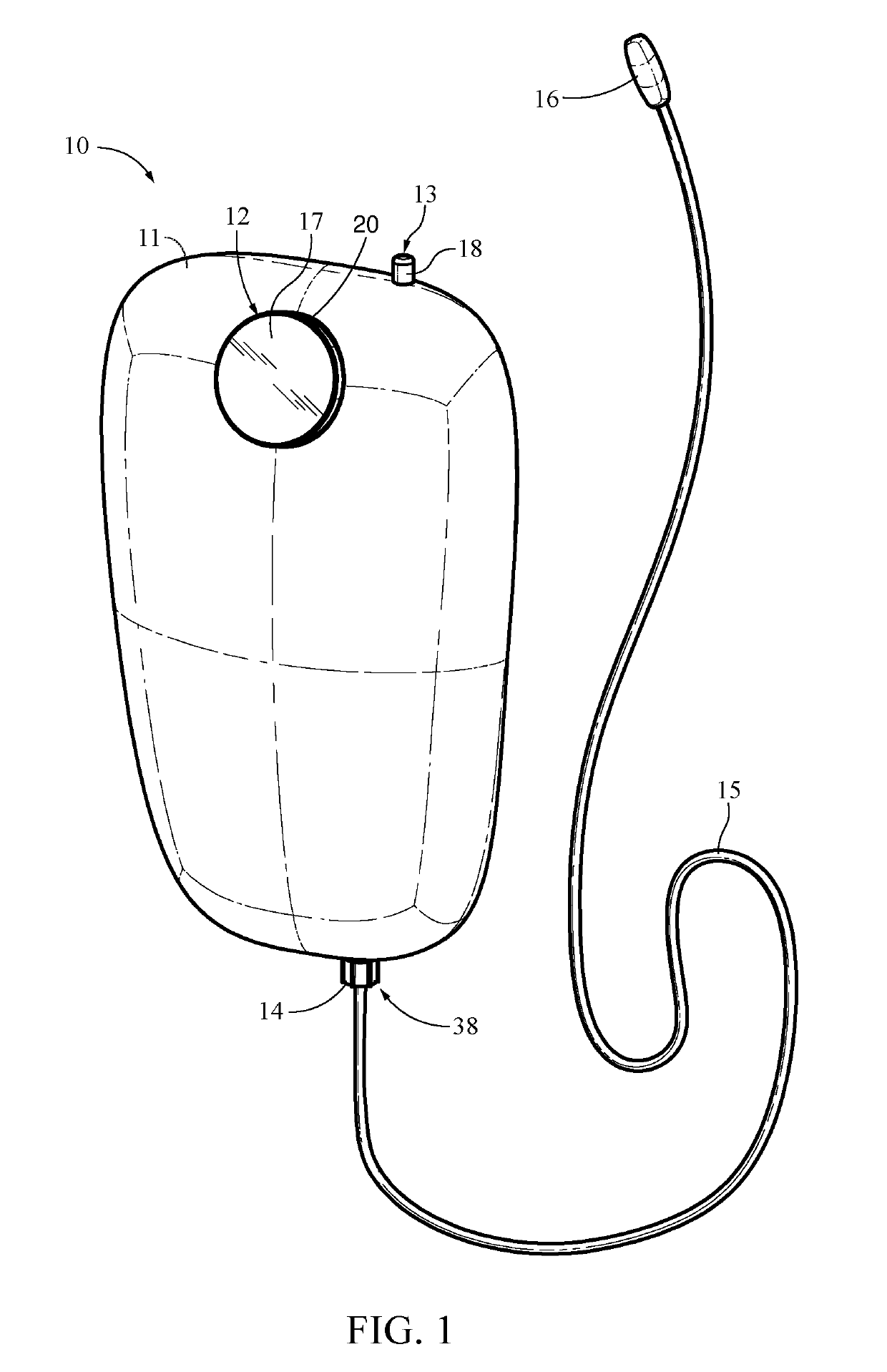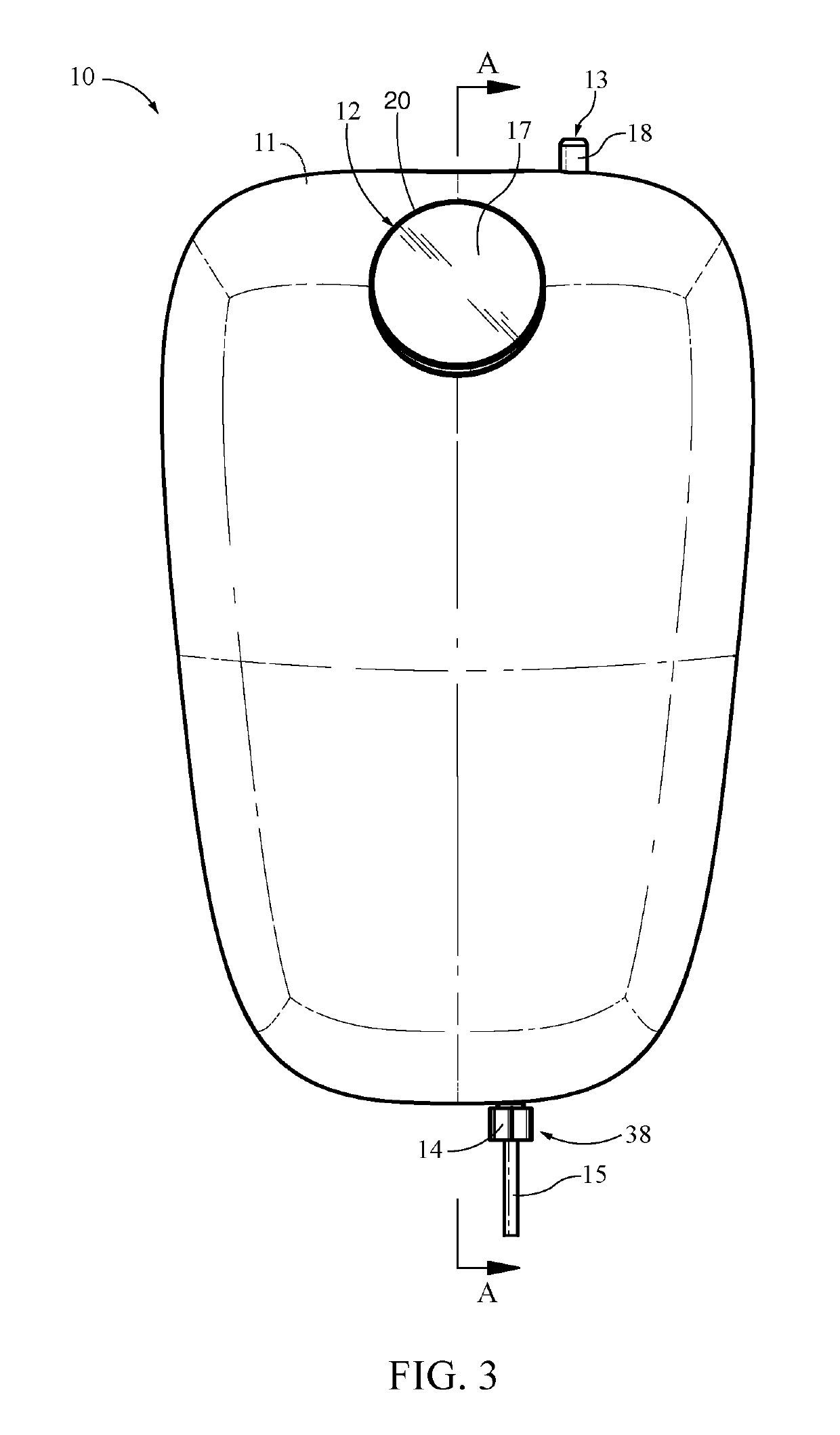Otherwise, people may not hydrate adequately, as taking frequent breaks to hydrate may not be desirable or even feasible while performing these activities.
Water bottles require the use of at least one hand, and can interrupt the user while performing a given activity.
However, if the effects are continuous, any negative hydration change may be associated with some level of performance loss.
Even with sufficient fluid quantities available and ad libitum access, subjects became significantly dehydrated during the
water bottle trial.
Problems with current systems include a plastic taste in the water; health concerns regarding the leaching of chemicals from the plastic reservoirs and other plastic components into the drinking water; difficulty and ineffectiveness with cleaning and
drying flexible reservoirs; health concerns regarding mold,
mildew, and / or
bacteria growth within these flexible reservoirs, often occurring due to ineffective or improper cleaning; the potential for the flexible plastic reservoirs to burst, rip, or tear when a user falls on them or when
impact is made with the reservoir during a sporting activity, potentially causing
water damage to other items held in a backpack by the user, such as
electronics, food, etc.
; the dissatisfaction of water becoming warm over the course of an activity in which the hydration
system is in use or stored in a hot environment such as an automobile during transport to an activity's location; the condensation formed on the reservoir's surface (also known as “sweating”) when cold water and ice are stored in the reservoir on a warm or hot day, causing the user and the contents of the backpack to become wet, potentially causing damage to
electronics or food; and the tendency for flexible plastic reservoirs to shape shift within the user's backpack, causing issues with weight load and other objects shifting around within the backpack.
However, as mentioned above, traditional water bottles and canteens are not as convenient and do not offer a hands-
free solution.
Multiple studies have shown that plastic water reservoirs do release small amounts of chemical compounds into the drinking water which are now known endocrine disruptors, which have some serious potential side effects.
Unfortunately, new studies have shown that BPS may be as hazardous or even more hazardous than BPA to
human health regarding endocrine disruption and other potential side effects.
And, just like BPA, the compound interfered with how cells respond to natural
estrogen, which is vital for
reproduction and other functions.
Cleaning is a Pain: Although improvements have been made to flexible plastic reservoir hydration systems, the reservoirs of these systems are often expensive and difficult to clean due to their construction.
These reservoirs or bags usually have many internal corners, crevices, and seams which are difficult to clean with conventional methods.
For example, these collapsible bags typically include small voids or traps which are difficult to clean and often require accessories for facilitating proper cleaning (e.g. a hanging rack, special brushes, etc.) to permit cleaning fluid access and / or air circulation.
In many cases, the difficulties associated with cleaning collapsible plastic reservoirs tend to outweigh the usefulness of the hydration bag as a desirable system for providing hydration to a user.
The rigid
metal reservoir hydration system, because of the materials used in the system, does not promote mold or
mildew growth or accumulation, allowing the recommended number of cleanings to be reduced to once per ten uses while still maintaining a sanitary hydration system.
Bacteria, which can accumulate in crevices within plastic reservoirs when not properly cleaned and dried, can also cause health issues for users.
Potential for the Flexible Plastic Reservoirs to Burst, Rip, or Tear: Off-road cyclists, runners, hikers, and other users of hydration systems may sometimes fall back on their hydration packs causing plastic reservoirs to burst, which can damage or ruin other contents carried within the backpack such as
electronics or clothing which needs to remain dry to maintain thermal qualities in cold environments.
Sharp edged or pointed objects within the backpack may also puncture plastic hydration reservoirs, causing the same damage described above to other contents in the backpack.
In addition to contents becoming wet from the
bursting or puncture of plastic hydration reservoirs, the user may become wet, potentially causing discomfort, inconvenience, or worse in particularly cold environments.
Typical plastic hydration reservoirs do not have insulating qualities.
Condensation or “Sweating”: To address the potential for
warm water during an outdoor or sporting activity, some users have added copious amounts of ice to the water inside the plastic reservoirs, which tends to keep
water cooler longer, however, when iced water is stored within a plastic reservoir, the reservoir tends to “sweat” in such a manner that
moisture condenses on the outer surface of the reservoir, getting other contents of the user's backpack and / or the user wet, which can damage electronics and cause other problems related to wet gear as described above.
As the liquid is emptied from the reservoir, the reservoir tends to shift or deform, resulting in shifting of the weight on the user and / or distorting the shape of the pack and / or items shifting around inside the pack due to volumetric displacement of the flexible plastic reservoirs.
The collapsible plastic reservoirs also tend to be cumbersome to fill with a fluid due to their lack of rigidity.
In some cases, a user may freeze the filled reservoir to form a “cold pack” or the like, and the reservoir may take any of a variety of undesirable shapes when frozen, depending on the configuration of the reservoir during the freezing process.
 Login to View More
Login to View More  Login to View More
Login to View More 


